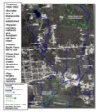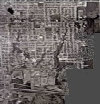The Como Watershed
The Como Creek watershed encompasses approximately 8.7 km2in south Coquitlam, a medium sized municipality in the north-eastern portion of the Metro Vancouver Regional District. It includes Como Lake (headwaters of Como Creek), four main tributaries (Popeye, Booth, Macdonald and Mill creeks) and significant parks and wildlife corridors. Land use varies from single family residential - commercial in the Uplands to commercial and light industrial in the Lowlands. The watershed flows south from its headwaters at Como Lake Avenue to the Fraser River east of historic Fraser Mills, and is within one of BC's oldest communities (Maillardville).
Over the last 60 years the area has undergone extensive growth and significant changes to land cover and land use. Yet with all this, the Como Creek watershed represents one of the last urban watersheds in the Tri-cities that supports a population of wild coho salmon. Other other species of conservation concern such as coastal cutthroat trout (both sea-run and resident), green heron and federally at risk Pacific great blue heron rely on the Como watershed for all or part of their life cycles.
Though much of the remaining ravine and riparian (streamside) corridors are remnants of the expansive old growth forests that once covered the area from the early to mid-part of the 20th century, reservoirs of natural diversity still remain such as Como Lake, the forested wetland on Como Creek south of Brunette Avenue, the upper Booth Creek ravine and upper Popeye Creek forest. Viewed as a sum of its parts, the Como Creek watershed is a critical corridor for wildlife moving north-south between the Fraser River and Port Moody/North Coquitlam and east-west between Burnaby Mountain and the Munday Park, Riverview and Coquitlam River areas.
The Como watershed represents an intensly urban place where people can still connect with salmon, wildlife and the lessons nature has to offer.
*The assignment of wildstock status is based on preliminary DNA
testing conducted by the CWG with DFO on Como and Booth Creek coho stocks. Minor stocking efforts through single incubation box projects
and classroom rearing activities may have made minor contributions to the "gene" pool in the past. However it is not considered to
have significantly affected the nature of present day returns that are likely remants of pre-settlement runs.
Last Updated:September
2008



